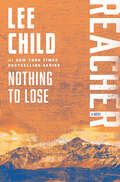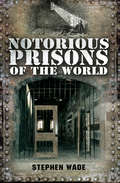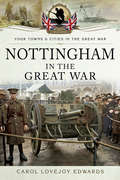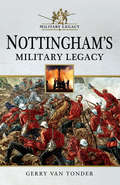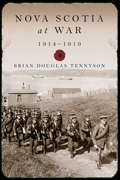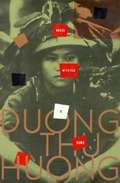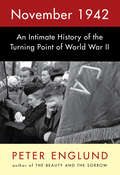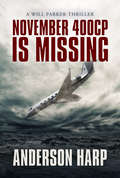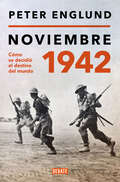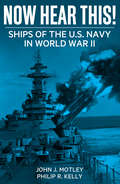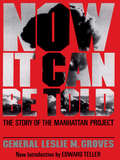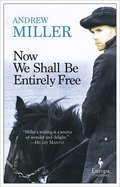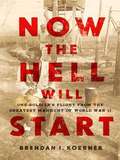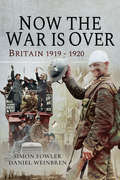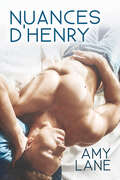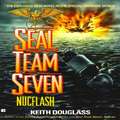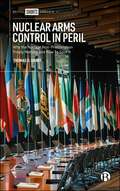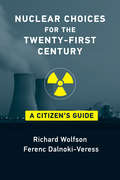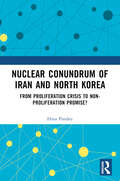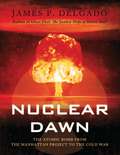- Table View
- List View
Nothing to Lose: A Jack Reacher Novel (Jack Reacher #12)
by Lee Child#1 NEW YORK TIMES BESTSELLER • Don&’t miss the hit streaming series Reacher! &“Explosive and nearly impossible to put down.&”—PeopleTwo small towns in the middle of nowhere: Hope and Despair. Between them, nothing but twelve miles of empty road. Jack Reacher can&’t find a ride, so he walks. All he wants is a cup of coffee. What he gets are four hostile locals, a vagrancy charge, and an order to move on. They&’re picking on the wrong guy. Reacher is a hard man. No job, no address, no baggage. Nothing at all, except hardheaded curiosity. What are the secrets that Despair seems so desperate to hide? With just one ally—a mysterious woman cop from Hope—and many enemies, Reacher goes up against a whole town, hunting the rich man at its core, cracking open his terrifying agenda, asking the question: Who has the edge—a man with everything to gain, or a man with nothing to lose?
Notorious Prisons of the World
by Stephen WadeA captivating history of doing time throughout the centuries: from England&’s medieval dungeons to America&’s supermax detention facilities. The first prisons were castle hellholes, places of neglect, oblivion, and slow death. Every civilization has had its dissenters, deviants, and political offenders, and so prisons became essential to the retention of power. As the centuries passed, and prisons were needed for other reprobates—such as debtors and common thieves—legal systems across the world began to cater to a growing variety of prisoners, and the business of incarceration began. Notorious Prisons of the World traces this development, from the state prisons of Athens and Rome, to the birth of the houses of correction and the penitentiary. Stephen Wade tells fascinating stories of the infamous penal colonies and state prisons across the stage of world history, from Alcatraz and Devil&’s Island to the fortress of Colditz, and from the Siberian gulags to the massive super jails sprouting across modern America. He also shares the stories of inmates and staff, political regimes, and the rise and fall of empires, all seen through the prison walls. In doing so, Wade throws light on the state-structured punishments which have stripped away individual freedoms. Sometimes with a degree of humanitarian concern, and sometimes through sheer barbarism.
Nottingham in the Great War (Your Towns & Cities in the Great War)
by Carol Lovejoy EdwardsThe years 1914-1918 cost many lives in the trenches of France and Belgium. Those trenches and the battles that were fought from them are well documented. But back home in towns and cities up and down the United Kingdom death and desperation were also apparent. Those left behind to carry on suffered from harsh winters, lack of food and fuel and flu epidemics. This is the story of the struggles of ordinary people with their everyday lives. It includes the opportunities presented to the criminal fraternity and the contribution that women made to the war effort by filling men's jobs and providing a home for the men to return to. If they were lucky enough to come home from the war.
Nottingham's Military Legacy (Military Legacy)
by Gerry van TonderTwo years after landing on English soil in 1066, William of Normandy erected a strategic castle at Nottingham, thereby creating an enduring military nexus through to the modern era.On 22 August 1642, in his endeavours to quash Parliamentarian insurrection in the Midlands, King Charles raised his standard over Nottingham Castle, a rallying call to all Royalists to support their monarch. Loyalty to the Crown was, however, divided, and before long Parliamentarian forces garrisoned the castle. Late in the eighteenth century, a town troop of Yeomanry was raised in Nottingham, the foundation of the future South Notts Yeomanry. The yeomanry assisted regular troops by helping restore peace during the so-called Bread Riots of 1795, at a time when many of the towns men had been committed to military duty during the French Revolutionary Wars. Five troops of the towns yeomanry were again called up for service during the civil unrest of the Luddite Riots of 181118. This pattern of service continued over several decades. Evolving into a regiment, the yeomanry were repeatedly deployed against civil dissenters the Nottingham Riot, and the Reform Bill and Chartist Riots.After seeing combat during the Peninsula Wars in 1815, in the latter half of the 1800s, the 59th (2nd Nottinghamshire) Regiment of Foot formed part of a British invasion force into Afghanistan from India, to curb Russian interventionism in this remote and desolate region. The outbreak of war in distant South Africa in 1899 placed enormous strain on Britains military capability. From Nottingham and other county towns, regiments of yeomanry, Hussars and Sherwood Rangers were dispatched to the hostile environment of the African veld. Nottinghams sons then answered a call to arms in their thousands, only to also perish in their thousands on the Godforsaken soils of France and Flanders during the holocaust that was the Great War. Through the Second World War to the present, Nottinghams military units underwent successive phases of metamorphosis from infantry to antiaircraft and searchlight formations, followed by the relatively recent absorption into a regional entity: the Mercian Regiment. Today, Nottinghams castle and surrounds bear the symbols of a rich and diverse military legacy symbols of remembrance, of tribute, and of a tableau of military pride from ancient times.
Nouveau départ (Libération #2)
by J. N. Ba TortugaLibération, tome 2Juste après avoir été libéré de l’armée, Eric Tremaine, soldat blessé au combat, tente de reconstruire sa vie, comme les docteurs ont réassemblé sa jambe brisée. Sans toit, car sa famille de Louisiane l’a rejeté, il se retrouve au Texas avec son ancien compagnon d’armée, Adam Winchester, et son petit-ami, Sage. Lorsqu’Eric décide d’arrêter de se morfondre, il est présenté à l’entraîneur Troy Daniels, qui a perdu ses deux jambes dans un accident lorsqu’il était adolescent. Troy sait ce que cela fait d’être en conflit avec son corps. Alors que la relation entre Eric et Troy ne commence pas de la meilleure des manières, les deux hommes trouvent rapidement un terrain d’entente en devenant amis, si ce n’est plus. Mais faire avancer les choses signifie trouver ce qu’ils ont à s’offrir mutuellement, avant d’être certains que l’amour ne leur causera pas plus de peine que de plaisir.
Nova Scotia at War, 1914–1919
by Brian Douglas TennysonAn in-depth historical study of Nova Scotia&’s role in WWI and its lingering impact on the region, its people, and its economy. Though the First World War ended in 1918, it continued to haunt Canada for generations. In Nova Scotia at War, 1915-1919, historian Brian Douglas Tennyson examines what was, for the people of Canada, an unprecedented period collective military trauma. As Tennyson demonstrates, the war effort didn&’t end with the brave soldiers and sailors who went overseas. It also touched the lives of civilians who worked in the fishery, on the farms, and in the forests, coals mines, and steel mills. A specialist in early twentieth-century Canadian political history, Tennyson examines the economic impact of the war with incisive clarity. In an often overlooked cost of the conflict, it shattered Nova Scotia's dream of becoming the Atlantic gateway and the industrial heartland of Canada. This volume includes 30 black and white photos.
Novel without a Name
by Duong Thu HuongThe story about a young soldier, Quan, who is fighting for North Vietnam and Communism during the Vietnam War.
November 1942: An Intimate History of the Turning Point of World War II
by Peter EnglundThe New York Times Book Review Editors' Choice • An intimate history of the most important month of World War II, completely based on the diaries, letters and memoirs of the people who lived through itAt the beginning of November 1942, it looked as if the Axis powers could still win the Second World War; at the end of that month, it was obviously just a matter of time before they would lose. In between were el-Alamein, Guadalcanal, the French North Africa landings, the Japanese retreat in New Guinea and the Soviet encirclement of the German 6th Army at Stalingrad. It may have been the most important thirty days of the twentieth century. In this hugely innovative and riveting history, Peter Englund has reduced an epoch-making event to its basic component: the individual experience.Englund&’s narrative is based solely on what he learned from the writings of soldiers and ordinary citizens alike. They comprise a remarkable, deeply personal resource. In thirty memorable days, among those we meet are: a Soviet infantryman at Stalingrad; an American pilot on Guadalcanal; an Italian truck driver in the North African desert; a partisan in the Belarussian forests; a machine gunner in a British bomber; a twelve-year-old girl in Shanghai; a university student in Paris; a housewife on Long Island; a shipwrecked Chinese sailor; a prisoner in Treblinka; a Korean &“comfort woman&” in Mandalay; Albert Camus, Vasily Grossman and Vera Brittain—forty characters in all. In addition, we experience the construction and launching of SS James Oglethorpe, a Liberty ship built in Savannah; the fate of U-604, a German submarine; the building of the first nuclear reactor in Chicago; and the making of Casablanca. Not since the publication of the author&’s last book, The Beauty and the Sorrow, which similarly looked at the First World War, have we had such a mesmerizing work of history.
November 400CP Is Missing (A Will Parker Thriller #6)
by Anderson HarpSLIPPERY SLOPE The PT Chevron Pacific Gulfstream banks towards the north after lifting off from the international airport at Kuala Lumpur. The oil-exploration team has reason to celebrate: The new oil field outside of Minas will be the biggest reserve in the history of Indonesia. And the country desperately needs it. The team breaks open the fifty-year-old bottle of scotch they&’ve been saving for just this moment. But in the next moment, the jet drops abruptly, like a rock, then turns sharply west on a path similar to that of a well-known commercial airliner from the recent past, descends through radar coverage . . . and disappears. Decorated Marine lieutenant colonel and small-town Georgia D.A. Will Parker has nothing to do with Chevron Pacific—until the wife of a former Marine buddy calls. She understands that her husband, who had been working for Chevron, is gone. But she wants answers, and the FBI and CIA are of little help. It&’s a request Will can&’t refuse. Will&’s contact on the ground is Retno Karims, a sharp, multilingual, former Miss Indonesia who speaks Bahasa Indonesian, Chinese, and Javanese. She also happens to be from Banda Aceh. Rumor has it that the terrorist group Laskar Mujahidin has reawakened and is operating somewhere in Banda Aceh on the northern point of Sumatra. No one doubts they&’re involved in downing the oil-company jet. Then again, no one believes any proof will stick, even if authorities locate the wreckage. Parker believes otherwise . . .Praise for RETRIBUTION &“Tense and authentic—reading this book is like living a real life mission.&”—Lee Child &“I seldom come across a thriller as authentic and well‑written as Retribution. Andy Harp brings his considerable military expertise to a global plot that&’s exciting, timely, and believable . . . to say that I&’m impressed is an understatement.&”—David Morrell, New York Times bestselling author of The Protector &“Retribution is a stunner: a blow to the gut and shot of adrenaline. Here is a novel written with authentic authority and bears shocking relevance to the dangers of today. It reminds me of Tom Clancy at his finest.&”—James Rollins, New York Times bestselling author of Bloodline &“Outstanding thriller with vivid characters, breakneck pacing, and suspense enough for even the most demanding reader. Harp writes with complete authenticity and a tremendous depth of military knowledge. A fantastic read—don&’t miss it!&”—Douglas Preston, #1 bestselling author of Impact
Noviembre 1942: Una historia íntima del momento decisivo de la Segunda Guerra Mundial
by Peter EnglundEl académico sueco Peter Englund trenza con maestría vidas y testimonios reales en este relato coral sobre el fatídico noviembre de 1942, que cambió el rumbo de la Segunda Guerra Mundial. La intrahistoria del mes más importante de la Segunda Guerra Mundial, contada exclusivamente a partir de los diarios, las cartas y las memorias de las personas que lo vivieron.A primeros de noviembre de 1942, parecía que las potencias del Eje todavía podían ganar la Segunda guerra mundial; antes de terminar ese mes era obviamente una cuestión de tiempo que fueran derrotadas. Entremedias había pasado el-Alamein, Guadalcanal, los desembarcos aliados en el norte de África, la retirada japonesa de Nueva Guinea y el avance soviético que rodeaba al Sexto Ejército alemán en Estalingrado. Puede que hayan sido los treinta días más importantes del siglo XX. En esta innovadora y fascinante obra, el sueco Peter Englund ha concentrado un momento histórico clave en su componente fundamental: la experiencia humana. Este relato está basado solo en los textos escritos tanto por soldados como por civiles, un recurso asombroso y profundamente humano. En treinta días memorables conoceremos entre otros a un soldado de infantería soviético en Estalingrado, un piloto estadounidense en Guadalcanal, un conductor de camiones italiano en el desierto del norte de África, un partisano en los bosques de Bielorrusia, un artillero en un bombardero británico, una niña de 12 años en Shanghái, una ama de casa en Long Island, un marinero chino naufragado, un prisionero en Treblinka, una «mujer de consuelo» coreana en Mandalay, Albert Camus, Vera Brittain... así hasta cuarenta personajes.Desde la publicación del anterior libro del autor, La belleza y el dolor de la batalla, que lanzaba una mirada similar a la primera guerra mundial, no ha aparecido un libro de historia tan fascinante. La crítica ha dicho:«Para educar a la mayoría, está magistralmente construido; como ciencia para la mayoría, es probablemente único; un logro de alcance internacional. Como literatura, es un libro que da qué pensar profundamente, lo que hace que el lector mire hacia dentro, hacia su propio tiempo».Expressen «Un coro poderoso y conmovedor, y de trasfondo el propio autor siempre presente como un espléndido guía, un maestro de la polifonía y la ambigüedad».Dagens Nyheter«Es como si toda la destreza de escritura de Englund se hubiera liberado. [...] Noviembre 1942 lo convierte en uno de los autores más importantes del país, de entre todas las categorías y de todos los tiempos».Sydsvenskan «Englund demuestra cómo la guerra redobla nuestro presente, lo hace vibrar. [...] Lo que de verdad vale la pena de la epopeya Noviembre de Englundes cómo el autor se las apaña para evocar el día a día de unos sucesos extraordinarios».Svenska Dagbladet «Un recordatorio brillante, en nuestra época, de cuán destructiva es la guerra en todos los niveles».Göteborgs-Posten
Now Hear This!: Ships of the U.S. Navy in World War II
by John J. MotleyNow Hear This!, first published in 1947, is an account of the combat actions of representative ships of the U.S. Navy during World War II in all theaters of the War. Included are accounts of historic battleships such as the Missouri and Iowa, aircraft carriers such as the Hornet and Saratoga, cruisers, destroyers, and submarines, as well as the exploits of lesser known, but vital to the war effort, merchant marine ships, transport ships, landing craft, tender ships, store ships, PT boats, hospital ships, and even ‘lowly’ tugs. The accounts, prepared from official U.S. Navy records and from interviews with crew members, are succinct, yet authoritative, making Now Hear This! an invaluable reference to the military scholar or anyone interested in learning more about the U.S. naval fleet, and the service, drama, and hardships the ships and their crews faced as they battled enemy ships, submarines, aircraft, mines, sharks, violent weather, and more. Included is an Appendix listing ships receiving various commendations, a list of naval vessels lost during the war, and a chronology of important Second World War naval events. Also included are 16 pages of photographs.
Now It Can be Told: The Story of the Manhattan Project
by Edward Teller Leslie R. Groves"General Leslie Groves and J. Robert Oppenheimer were the two men chiefly responsible for the building of the first atomic bomb at Los Alamos, code name ""The Manhattan Project. "" As the ranking military"
Now We Shall Be Entirely Free
by Andrew MillerA British soldier flees to the Hebrides for reprieve from war while something else hunts for him in this historical thriller by the author of The Crossing.When Cap. John Lacroix returns home from Spain, wounded, unconscious, and alone, he believes that he has seen the worst of what men may do. It is 1809, and in England’s wars against Napoleon, the Battle of Corruna stands out as a humiliation: a once-proud army forced to retreat, civilized men reduced to senseless acts of cruelty.Slowly regaining his health, Lacroix journeys north to the misty isles of Scotland with the intent of forgetting the horrors of the war. Unbeknownst to him, however, something else has followed him back from the war—something far more dangerous than a memory . . .A New York Times Notable Book of 2019“Miller’s writing is a source of wonder and delight.” —Hilary MantelPraise for New We Shall Be Entirely Free“Mr. Miller strikes an impressive balance between adventure and atmosphere.” —The Wall Street Journal“Miller acutely imagines the war-scarred psychology of his characters . . . and uses the historical setting to great advantage.” —TheNew Yorker“Miller is in fine form here, mixing an unforgettable cat-and-mouse chase with a moving love story.” —Kirkus Reviews
Now and Again
by Charlotte RoganA provocative novel about the fallout from a search for truth by the author of the national bestseller The Lifeboat.For Maggie Rayburn--wife, mother, and secretary at a munitions plant--life is pleasant, predictable, and, she assumes, secure. When she finds proof of a high-level cover-up on her boss's desk, she impulsively takes it, an act that turns her world, and her worldview, upside down. Propelled by a desire to do good--and also by a newfound taste for excitement--Maggie starts to see injustice everywhere. Soon her bottom drawer is filled with what she calls "evidence," her small town has turned against her, and she must decide how far she will go for the truth. For Penn Sinclair--Army Captain, Ivy League graduate, and reluctant heir to his family's fortune--a hasty decision has disastrous results. Home from Iraq and eager to atone, he reunites with three survivors to expose the truth about the war. They launch a website that soon has people talking, but the more they expose, the cloudier their mission becomes. Now and Again is a blazingly original novel about the interconnectedness of lives, the limits of knowledge, and the consequences of doing the right thing.
Now the Hell Will Start
by Koerner Brendan I.An epic saga of hubris , cruelty, and redemption, Now the Hell Will Start tells the remarkable tale of the greatest manhunt of World War II. Herman Perry, besieged by the hardships of the Indo-Burmese jungle and the racism meted out by his white commanding officers, found solace in opium and marijuana. But on one fateful day, Perry shot his unarmed white lieutenant in the throes of an emotional collapse and fled into the jungle. Brendan I. Koerner spent nearly five years chasing Perry's ghost to the most remote corners of India and Burma. Along the way, he uncovered the forgotten story of the Ledo Road's GIs, for whom Jim Crow was as powerful an enemy as the Japanese-and for whom Herman Perry, dubbed the jungle king, became an unlikely folk hero. .
Now the War Is Over: Britain, 1919–1920
by Daniel Weinbren Simon FowlerHow did Britain respond to the momentous events of 1919 and 1920 as it adjusted to peace after four years of war? What were the challenges the British people faced and how did they cope with the profound changes that confronted them? Now the War Is Over seeks to answer these questions. It looks at what happened in every sphere of life and it shows how, even today, we are still dealing with the consequences of those years of transition.Across Europe there were revolutions, a war for independence occurred in Ireland, and on mainland Britain there were widespread race riots. However, most servicemen simply wanted to come home to their families and a secure job. Some hoped for a return to the certainties of a pre-war world, but this was impossible too much had happened. As they explore the troubled state of Britain immediately after the war Simon Fowler and Daniel Weinbren give us a fascinating insight into how the global conflict changed the direction of the nation.
Now with the Morning Star
by Thomas KernanNow with the Morning Star, first published in 1944, is a well-crafted account of life in Germany during World War II, beginning with life in a peaceful monastery. Soon, however, the Nazis arrive and one of the monks is arrested and subsequently interned in a camp. American author Thomas Kernan, himself a prisoner of the Germans, wrote the book in 1943-44 during his own internment in a camp near Stuttgart. The book portrays life under Nazi-ruled Germany as well as the monk’s struggle to survive.As author Kernan states in the book’s introduction: “This book was written between November 1943 and March 1944, the last months of my internment at Baden-Baden in Germany. Thanks to the fact that I was repatriated with diplomatic immunity, I was able to bring the manuscript out of Germany with me, and home to America on the S.S. Gripsholm.”
Nuances d'Henry: Shades Of Henry Fr (Une histoire de la Piaule #1)
by Amy LaneUne tentative d&’acte d&’intégrité coûte tout à Henry Worrall – sa carrière militaire, sa famille et le petit ami secret qui l&’a gardé piégé pendant onze ans. Désespéré, Henry arrive à la porte de son frère, et on lui offre un endroit où vivre et un travail comme homme à tout faire dans une piaule pour jeunes stars du porno.Le passé de Lance Luna lui a donné des raisons de faire du porno, mais tandis qu&’il poursuit son internat dans un hôpital local, elles ressemblent désormais plus à des excuses. Il a l&’argent pour déménager de la piaule et vivre sa propre vie – mais qui a besoin d&’intimité quand on s&’occupe d&’une bande de jeunes hommes qui pensent que travailler du pénis fait d&’eux des adultes ?Lance s&’inquiète que Henry ne s&’intègre pas, mais celui-ci a un faible pour les jeunes hommes perdus et la manière pour les aider. Alors que Lance et Henry trouvent leur rythme en tant que mères poules, un meurtre et les fantômes du passé violent d&’Henry font irruption dans leurs vies. Lance sait que celui-ci n&’est pas capable de meurtre, mais est-il capable de prendre soin du cœur de Lance ?
Nucflash (Seal Team Seven, #3)
by Keith DouglassPart of Third Platoon, SEAL Team Seven, is in Great Britain participating in a training exchange program with the British SAS when an international terrorist organization hijacks an oil platform in the North Sea. The terrorists claim to have a nuclear device which they will detonate if their demands are not met. The remainder of Third Platoon quickly arrives on the scene and the SEALS assume the primary responsibility for reclaiming the oil platform, freeing the hostages and finding and neutralizing the nuclear device.
Nuclear Arms Control in Peril: Why the Nuclear Non-Proliferation Treaty Matters and How to Save It
by Thomas D. GrantIn this book, a former US Department of State senior arms control official critically analyses two pivotal nuclear arms control treaties: the established Treaty on the Non-Proliferation of Nuclear Weapons (NPT) and the rising Treaty on the Prohibition of Nuclear Weapons (TPNW). The book offers a concise and critical analysis of the two, illuminating both their strengths and shortcomings. The author acknowledges the idealistic goal of the TPNW but argues that its immediate abolitionist stance lacks a roadmap for achievement. Instead, the book advocates realistic progress within the NPT framework. It provides twelve key negotiation topics for fostering meaningful dialogue among nuclear-weapon states, while emphasizing the urgency of concrete action in a world facing growing nuclear threats.
Nuclear Choices for the Twenty-First Century: A Citizen's Guide
by Richard Wolfson Ferenc Dalnoki-VeressAn authoritative and unbiased guide to nuclear technology and the controversies that surround it.Are you for nuclear power or against it? What's the basis of your opinion? Did you know a CT scan gives you some 2 millisieverts of radiation? Do you know how much a millisievert is? Does irradiation make foods safer or less safe? What is the point of a bilateral Russia-US nuclear weapons treaty in a multipolar world? These are nuclear questions that call for nuclear choices, and this book equips citizens to make these choices informed ones. It explains, clearly and accessibly, the basics of nuclear technology and describes the controversies surrounding its use.
Nuclear Conundrum of Iran and North Korea: From Proliferation Crisis to Non-Proliferation Promise?
by Hina PandeyThis book examines Iran and North Korea from a non-proliferation lens. It highlights how these two countries stand out as nuclear challenges vis-à-vis the NPT and unpacks their nuclear history, recent developments, nuclear resolve in the times of the pandemic and future challenges in a comprehensive manner. It shows how these two issues remain similar, distinguished, dynamic but static so far progress on non-proliferation is concerned. The book will be a valuable read for students, scholars, academicians, policy practitioners and anyone invested and interested in nuclear issues. Print edition not for sale in South Asia (India, Sri Lanka, Nepal, Bangladesh, Pakistan and Bhutan)
Nuclear Dawn
by James DelgadoWhen President Obama and others say they want to end America's dependence on foreign oil, the vision is usually presented in terms of "a new Manhattan Project." So what really was the Manhattan Project? According to James Delgado, at the start of the project in 1942, the element plutonium only existed in microscopic quantities. By June 16, 1945, the date of the world's first nuclear bomb test, America had a fully-operational plutonium industry capable of producing hundreds of pounds of the fissionable material. In just three short years, nuclear weapon technology had progressed from infancy to the world stage. Delgado, the co-host of the National Geographic Television series "The Sea Hunters," tells the breathtaking story of the original Manhattan Project and its aftermath. While most previous authors have focused on either the scientific or the social history of the events, Delgado's is the first to spotlight the military and political phases of the atom bomb. In crisp prose, he covers the background of the bomb in the labs in Europe, Britain, and America, but the story picks up speed after the bombing of Pearl Harbor and the declaration of war by America.While most people recognize Robert Oppenheimer as the father of the bomb, readers of Nuclear Dawn will be surprised to learn that gave birth more in the sense that Henry Ford gave birth to the auto industry. In Delgado's narrative, Oppenheimer's role as master organizer and astute business manager is emphasized. What's more, few before Delgado have understood how deeply involved the US Army was in the project. From the very beginning, the program was run by army officers, financed by secret wartime military funds--to the tune of billions of dollars, staffed by army engineers and scientists, and made possible by army bureaucracy. Delgado also shows that without the army's ordnance expertise at Los Alamos, Oppenheimer's team could not have turned nuclear technology into a workable bomb.Several other unique aspects of Nuclear Dawn turn on the military's role in the project. For example, Delgado tells the full story of the army air force's 509th fighter battalion, which was headed by an iconoclastic colonel named Paul Tibbets. Tibbets' battalion consisted of over 1,200 pilots and crew dedicated to a singular task: delivering an atomic bomb to Japan. Delgado tells how as part of their training, the Utah-based crews would fly practice sorties to Cuba and back, over and over again. Another little-known aspect of the Manhattan Project drawn out be Delgado is the post-war bickering that quickly arose between the army and navy over who would control the bomb. James Delgado's new book fills a very important gap in our understanding of the enormous changes that the United States military underwent during WWII.From the Hardcover edition.
Nuclear Deterrence In The 21st Century: Lessons From The Cold War For A New Era Of Strategic Piracy
by Thérèse DelpechDeterrence remains a primary doctrine for dealing with the threat of nuclear weapons in the 21st century. The author reviews the history of nuclear deterrence and calls for a renewed intellectual effort to address the relevance of concepts such as first strike, escalation, extended deterrence, and other Cold War–era strategies in today's complex world of additional superpowers, smaller nuclear powers, and nonstate actors.
